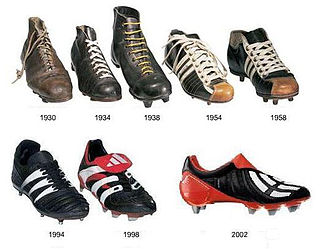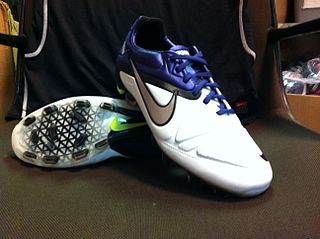
A shoe is an item of footwear intended to protect and comfort the human foot. Shoes are also used as an item of decoration and fashion. The design of shoes has varied enormously through time and from culture to culture, with appearance originally being tied to function. Additionally, fashion has often dictated many design elements, such as whether shoes have very high heels or flat ones. Contemporary footwear in the 2010s varies widely in style, complexity and cost. Basic sandals may consist of only a thin sole and simple strap and be sold for a low cost. High fashion shoes made by famous designers may be made of expensive materials, use complex construction and sell for hundreds or even thousands of dollars a pair. Some shoes are designed for specific purposes, such as boots designed specifically for mountaineering or skiing.

Footwear refers to garments worn on the feet, which originally serves to purpose of protection against adversities of the environment, usually regarding ground textures and temperature. Footwear in the manner of shoes therefore primarily serves the purpose to ease the locomotion and prevent injuries. Secondly footwear can also be used for fashion and adornment as well as to indicate the status or rank of the person within a social structure. Socks and other hosiery are typically worn additionally between the feet and other footwear for further comfort and relief. Cultures have different customs regarding footwear. These include not using any in some situations, usually bearing a symbolic meaning. This can however also be imposed on specific individuals to place them at a practical disadvantage against shod people, if they are excluded from having footwear available or are prohibited from using any. This usually takes place in situations of captivity, such as imprisonment or slavery, where the groups are among other things distinctly divided by whether or whether not footwear is being worn. In these cases the use of footwear categorically indicates the exercise of power as against being devoid of footwear, evidently indicating inferiority.

Sandals are an open type of footwear, consisting of a sole held to the wearer's foot by straps going over the instep and, sometimes, around the ankle. Sandals can also have a heel. While the distinction between sandals and other types of footwear can sometimes be blurry, the common understanding is that a sandal leaves all or most of the foot exposed. People may choose to wear sandals for several reasons, among them comfort in warm weather, economy, and as a fashion choice.
Jungle boots are a type of combat boot designed for use in jungle warfare or in hot, wet, and humid environments where a standard leather combat boot would be uncomfortable or unsuitable to wear. Jungle boots have vent holes in the instep and sometimes a canvas upper to aid in ventilation and drainage of moisture.

Air Jordan is a brand of basketball shoes, athletic, casual, and style clothing produced by Nike. It was created for former NBA player and six-time NBA Finals MVP Michael Jordan. The original Air Jordan sneakers were produced exclusively for Michael Jordan in early 1984, and released to the public in late 1984. The shoes were designed for Nike by Peter Moore, Tinker Hatfield, and Bruce Kilgore.

Hiking (walking) boots are footwear specifically designed for protecting the feet and ankles during outdoor walking activities such as hiking. They are one of the most important items of hiking gear, since their quality and durability can determine a hiker's ability to walk long distances without injury. Hiking boots are constructed to provide comfort for walking considerable distance over rough terrain. Boots that protect the hiker's feet and heel are recommended. Hiking boots give ankle support and are fairly stiff. A less popular alternative is to use light trainers with thin soles. Footwear should be neither too loose nor too tight, to help prevent blisters and sore feet. Hiking socks that wick sweat from the feet, provide warmth, and cushion the feet are recommended and a thin, inner sock may also help. Most hiking boots are also designed for other outdoor activities such as backpacking, climbing, mountaineering, and hunting.

Skate shoes or skateboard shoes are a type of footwear specifically designed and manufactured for use in skateboarding. While numerous non-skaters choose to wear skate shoes as they are popular in fashion, the design of the skate shoe includes many features designed especially for use in skateboarding, including a vulcanized rubber or polyurethane sole with minimal tread pattern or no pattern, a composition leather or suede upper, and double or triple stitching to extend the life of the upper material. A low, padded tongue is often included for comfort.

Football boots, called cleats or soccer shoes in North America, are an item of footwear worn when playing football. Those designed for grass pitches have studs on the outsole to aid grip. From simple and humble beginnings football boots have come a long way and today find themselves subject to much research, development, sponsorship and marketing at the heart of a multi-national global industry. Modern "boots" are not truly boots in that they do not cover the ankle - like most other types of specialist sports footwear, their basic design and appearance has converged with that of sneakers since the 1960s.

Nike Air Max is a line of shoes produced by Nike, Inc., with the first model released in 1987. Air Max shoes are identified by their midsoles incorporating flexible urethane pouches filled with pressurized gas, visible from the exterior of the shoe and intended to provide cushioning underfoot. Air Max was conceptualized by Tinker Hatfield, who initially worked for Nike designing stores.

Cycling shoes are shoes purpose-built for cycling. There are a variety of designs depending on the type and intensity of the cycling for which they are intended. Key features include rigidity, for more-efficient transfer of power from the cyclist to the pedals, weight, a method of attaching the shoe firmly to the pedal and adaptability for use on and off the bicycle. Most high-performance cycling shoes can be adjusted while in use, via a quick-adjusting system that has largely replaced laces.

A Goodyear welt is a strip of leather, rubber, or plastic that runs along the perimeter of a shoe outsole. The machinery used for the process was invented in 1869 by Charles Goodyear Jr., the son of Charles Goodyear. It has been noted by historians that Goodyear was a frequent visitor to the shoe factory of William J. Dudley, founder of Johnston & Murphy, where early work on sole stitching equipment was performed.

Nike Grind is a collection of recycled materials developed by Nike that is composed of pre-consumer manufacturing scraps, recycled post-consumer shoes from the Reuse-A-Shoe program, and unsellable footwear. The purpose of Nike Grind is to eliminate waste and close the loop on Nike's product lifecycle.

Adidas Predator are a range of Football boots developed by German sportswear manufacturers Adidas, introduced in 1994. Predator are based on a prototype concept from the Australian former footballer Craig Johnston. The common feature of the Predator range is the presence of rubber patches or strips on the top of the shoe, designed to increase friction between the boot and the ball. In late 2010, Adidas designed the new "Power-spine" technology, which they claim improves shot power by reducing the amount the foot bends back as it kicks the ball.

The Mercurial Vapor is a football boot manufactured by Nike. The boot is known for being lightweight. Because of this, the boot is endorsed by many players for whom speed is part of their game, notably wingers or strikers, such as Cristiano Ronaldo, Neymar, Kylian Mbappé, Eden Hazard, Raheem Sterling, Zlatan Ibrahimović, Didier Drogba, Luka Modrić, Arturo Vidal, Douglas Costa, Xherdan Shaqiri, Stephan El Shaarawy, Alexis Sánchez, Philippe Coutinho and many more.

Cleats or studs are protrusions on the sole of a shoe or on an external attachment to a shoe that provide additional traction on a soft or slippery surface. They can be conical or blade-like in shape and can be made of plastic, rubber or metal. The type worn depends on the environment of play: grass, ice, artificial turf, or other grounds.
adiPURE was a range of football boots developed by the German sportswear manufacturer Adidas and introduced at the end of 2007. The company based the design of the AdiPure on its own boots from the 1978 World Cup. In order to remain practical for the modern game, the boot's construction included updated materials and improved manufacturing techniques, to create a product significantly lighter than its 1978 counterpart.

The Nike CTR360 is a line of association football boots manufactured by Nike.
The Nike Cortez is the first track shoe released by Nike in 1972, and is therefore thought to be a significant aspect to the success of the company. The Nike Cortez was first designed by Nike co-founder Bill Bowerman, an Olympic-class track coach, who felt that athletes needed a comfortable and durable running shoe designed for distance training and road running. The Nike Cortez was released at the peak of the 1972 Summer Olympics, which is why it gained rapid exponential interest by the general public.

The Nike Hypervenom is a football boot manufactured by Nike. This type of boot is said to be for traction, power, and agility, designed for deceptive players. Therefore, it is endorsed/worn by players, notably forwards, such as Robert Lewandowski, Harry Kane, Edinson Cavani, Gonzalo Higuaín, Mauro Icardi and Thiago.

Adidas Parley is a collection of clothing and footwear originated from the collaboration of German multinational company Adidas and "Parley for the Oceans", an organization that addresses environmental threats towards the oceans, through plastic pollution.

















